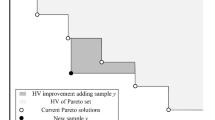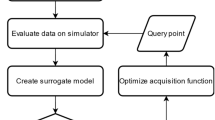Abstract
Engineering design is usually a daunting optimization task which often involving time-consuming, even computation-prohibitive process. Variable fidelity metamodeling has been developed as an efficient approach to alleviate this issue, owing to its capacity of achieving accurate metamodels within limited sample size. An output mapping modeling method is proposed in this paper as an alternative variable fidelity metamodeling method in which the low fidelity outputs is directly mapped to the high fidelity outputs through least square support vector regression. Furthermore, a nested Latin hypercube design method is developed for the output mapping modeling, in which a simple sampling design is treated as a building block or DOE seed to be translated and propagated through the design space, resulting in a final sampling configuration. Effectiveness of the proposed method are demonstrated by several numerical functions and two engineering design problem, in which different sample sizes, predictive accuracies and robustness are considered.

















Similar content being viewed by others
References
Messac A, Mullur AA (2008) A computationally efficient metamodeling approach for expensive multiobjective optimization. Optim Eng 9(1):37–67. https://doi.org/10.1007/s11081-007-9008-0
Ni B, He F-Z, Pan Y-T, Yuan Z-Y (2016) Using shapes correlation for active contour segmentation of uterine fibroid ultrasound images in computer-aided therapy. Appl Math J Chin Univ Series B 31(1):37–52. https://doi.org/10.1007/s11766-016-3340-0
Berci M, Gaskell PH, Hewson RW, Toropov VV (2011) Multifidelity metamodel building as a route to aeroelastic optimization of flexible wings. Proc Instit Mec Eng Part C: J Mech Eng Sci 225(7):2115–2137. https://doi.org/10.1177/0954406211403549
Zheng J, Gao L, Qiu HB, Shao XY, Jiang P (2016) Variable fidelity metamodel-based analytical target cascading method for green design. Int J Adv Manuf Technol 87(5-8):1203–1216. https://doi.org/10.1007/s00170-012-4705-z
Koziel S, Ciaurri DE, Leifsson L (2011) Surrogate-based methods. In: Computational optimization, methods and algorithms. Springer, pp 33–59
Leifsson L, Koziel S (2011) Variable-fidelity aerodynamic shape optimization. In: Koziel S, Yang XS (eds) Computational optimization, methods and algorithms, vol 356. Studies in Computational Intelligence, pp 179–210
Alexandrov NM, Lewis RM (2000) Optimization with variable-fidelity models applied to wing design. In: 38th Aerospace sciences meeting & exhibit. AIAA, Reno
Alexandrov NA, Lewis RM, Gumbert CR, Green LL, Newman PA (2001) Approximation and model management in aerodynamic optimization with variable-fidelity models. J Aircr 38(4):1093–1101
Sun GY, Li GY, Zhou SW, Xu W, Yang XJ, Li Q (2011) Multi-fidelity optimization for sheet metal forming process. Struct Multidiscip Optim 44(1):111–124. https://doi.org/10.1007/s00158-010-0596-5
Leary SJ, Bhaskar A, Keane AJ (2003) A knowledge-based approach to response surface modelling in multifidelity optimization. J Global Optim 26(3):297–319
Zhou Q, Shao X, Jiang P, Gao Z, Wang C, Shu L (2016) An active learning metamodeling approach by sequentially exploiting difference information from variable-fidelity models. Adv Eng Inf 30(3):283–297. https://doi.org/10.1016/j.aei.2016.04.004
Rodriguez JF, Renaud JE, Wujek BA, Tappeta RV (2000) Trust region model management in multidisciplinary design optimization. J Comput Appl Math 124(1-2):139–154. https://doi.org/10.1016/s0377-0427(00)00424-6
Perez VM, Renaud JE, Watson LT (2008) Reduced sampling for construction of quadratic response surface approximations using adaptive experimental design. Eng Comput 25(7-8):764–782. https://doi.org/10.1108/02644400810909607
Won KS, Ray T (2005) A framework for design optimization using surrogates. Eng Optimiz 37(5):685–703. https://doi.org/10.1080/03052150500211911
Wang GG, Shan S (2007) Review of metamodeling techniques in support of engineering design optimization. J Mech Des 129(4):370. https://doi.org/10.1115/1.2429697
Qian PZG, Ai MY, Wu CFJ (2009) Construction of nested space-filling designs. Ann Statist 37 (6A):3616–3643. https://doi.org/10.1214/09-aos690
Zheng J, Gao L, Jiang P Block latin hypercube design for variable-fidelity meta-modeling. In: 43rd International conference on computers and industrial engineering 2013, CIE 2013, October 16, 2013 - October 18, 2013, Hong Kong, Hong kong, 2013. Proceedings of international conference on computers and industrial engineering. CIE. Curran Associates Inc., pp 653–659
Kennedy MC, O’Hagan A (2001) Bayesian calibration of computer models. J R Statist Soc Series B (Statist Methodol) 63(3):425–464
Qian ZG, Joseph CCSVR (2006) Building sugrrote models based on detailed and approximate simulation. J Mech Des 128:668–677. https://doi.org/10.1115/1.2179459
Qian PZG, Tang BX, Wu CFJ (2009) Nested space-filling designs for computer experiments with two levels of accuracy. Statistica Sinica 19(1):287–300
Haaland B, Qian PZG (2010) An approach to constructing nested space-filling designs for multi-fidelity computer experiments. Statistica Sinica 20(3):1063–1075
Rennen G, Husslage B, Van Dam E, Den Hertog D (2010) Nested maximin latin hypercube designs. Struct Multidiscip Optim 41(3):371–395. https://doi.org/10.1007/s00158-009-0432-y
Yi J, Li XY, Xiao M, Xu JN, Zhang L (2017) Construction of nested maximin designs based on successive local enumeration and modified novel global harmony search algorithm. Eng Optimiz 49(1):161–180. https://doi.org/10.1080/0305215x.2016.1170825
Clarke SM, Griebsch JH, Simpson TW (2005) Analysis of support vector regression for approximation of complex engineering analyses. J Mech Des 127(4):1077. https://doi.org/10.1115/1.1897403
Pan F, Zhu P, Zhang Y (2010) Metamodel-based lightweight design of B-pillar with TWB structure via support vector regression. Comput Struct 88(1-2):36–44. https://doi.org/10.1016/j.compstruc.2009.07.008
Keerthi SS, Lin CJ (2003) Asymptotic behaviors of support vector machines with Gaussian kernel. Neural Comput 15(5):1667–1689. https://doi.org/10.1162/089976603321891855
Liao RJ, Zheng HB, Grzybowski S, Yang LJ (2011) Particle swarm optimization-least squares support vector regression based forecasting model on dissolved gases in oil-filled power transformers. Electr Power Syst Res 81(10):2074–2080. https://doi.org/10.1016/j.epsr.2011.07.020
Joseph VR, Hung Y, Sudjianto A (2008) Blind Kriging: a new method for developing metamodels. J Mech Des 130(3):031102. https://doi.org/10.1115/1.2829873
Zheng J, Shao X, Gao L, Jiang P, Qiu H (2014) Difference mapping method using least square support vector regression for variable-fidelity metamodelling. Eng Optimiz, 1–18. https://doi.org/10.1080/0305215x.2014.918114
Zhou Q, Shao X, Jiang P, Zhou H, Shu L (2015) An adaptive global variable fidelity metamodeling strategy using a support vector regression based scaling function. Simul Modell Pract Theory 59:18–35. https://doi.org/10.1016/j.simpat.2015.08.002
Gano SE, Renaud JE (2004) Variable fidelity optimization using a Kriging based scaling function. In: 10th AIAA/ISSMO multidisciplinary analysis and optimization conference. Albany
Gano SE, Renaud JE, Martin JD, Simpson TW (2006) Update strategies for kriging models used in variable fidelity optimization. Struct Multidiscip Optim 32(4):287–298. https://doi.org/10.1007/s00158-006-0025-y
Sun GY, Li GY, Li Q (2012) Variable fidelity design based surrogate and artificial bee colony algorithm for sheet metal forming process. Finite Elem Analysis Des 59:76–90. https://doi.org/10.1016/j.finel.2012.04.012
Gao L, Xiao M, Shao XY, Jiang P, Nie L, Qiu HB (2012) Analysis of gene expression programming for approximation in engineering design. Struct Multidiscip Optim 46(3):399–413. https://doi.org/10.1007/s00158-012-0767-7
Jin R, Chen W, Simpson TW (2001) Comparative studies of metamodelling techniques under multiple modelling criteria. Struct Multidiscip Optim 23(1):1–13. https://doi.org/10.1007/s00158-001-0160-4
Balabanov V, Venter G (2004) Multi-fidelity optimization with high-fidelity analysis and low-fidelity Gradients. In: 10th AIAA/ISSMO multidisciplinary analysis and optimization conference. Albany
Acknowledgements
This research was supported by the National Nature Science Foundation of China under grant NO.51505439, the Research Fund for the Doctoral Program of Higher Education of China under grant No.2014M562085 and the Fundamental Research Funds for the Central Universities, CUG: Grant no. CUGL150821.
Author information
Authors and Affiliations
Corresponding author
Rights and permissions
About this article
Cite this article
Zheng, J. An output mapping variable fidelity metamodeling approach based on nested Latin hypercube design for complex engineering design optimization. Appl Intell 48, 3591–3611 (2018). https://doi.org/10.1007/s10489-018-1164-8
Published:
Issue Date:
DOI: https://doi.org/10.1007/s10489-018-1164-8




